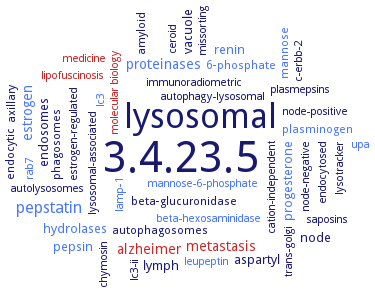3.4.23.5: cathepsin D
This is an abbreviated version!
For detailed information about cathepsin D, go to the full flat file.

Word Map on EC 3.4.23.5 
-
3.4.23.5
-
lysosomal
-
pepstatin
-
estrogen
-
metastasis
-
alzheimer
-
proteinases
-
aspartyl
-
node
-
vacuole
-
lymph
-
renin
-
pepsin
-
endosomes
-
progesterone
-
hydrolases
-
endocytic
-
phagosomes
-
amyloid
-
beta-glucuronidase
-
plasminogen
-
mannose
-
6-phosphate
-
axillary
-
autophagosomes
-
saposins
-
lysosomal-associated
-
leupeptin
-
plasmepsins
-
beta-hexosaminidase
-
missorting
-
mannose-6-phosphate
-
chymosin
-
lysotracker
-
lipofuscinosis
-
lc3-ii
-
autophagy-lysosomal
-
rab7
-
ceroid
-
estrogen-regulated
-
immunoradiometric
-
medicine
-
lc3
-
lamp-1
-
node-negative
-
trans-golgi
-
upa
-
endocytosed
-
node-positive
-
c-erbb-2
-
autolysosomes
-
cation-independent
-
molecular biology
- 3.4.23.5
- lysosomal
- pepstatin
- estrogen
- metastasis
- alzheimer
- proteinases
-
aspartyl
- node
- vacuole
- lymph
- renin
- pepsin
- endosomes
- progesterone
- hydrolases
-
endocytic
-
phagosomes
-
amyloid
- beta-glucuronidase
- plasminogen
- mannose
- 6-phosphate
-
axillary
-
autophagosomes
-
saposins
-
lysosomal-associated
- leupeptin
-
plasmepsins
- beta-hexosaminidase
-
missorting
- mannose-6-phosphate
- chymosin
-
lysotracker
- lipofuscinosis
-
lc3-ii
-
autophagy-lysosomal
- rab7
-
ceroid
-
estrogen-regulated
-
immunoradiometric
- medicine
- lc3
- lamp-1
-
node-negative
-
trans-golgi
- upa
-
endocytosed
-
node-positive
-
c-erbb-2
-
autolysosomes
-
cation-independent
- molecular biology
Reaction
Specificity similar to, but narrower than, that of pepsin A. Does not cleave the Gln4-His bond in B chain of insulin =
Synonyms
BmCatD, CAD 1, CAD 2, CAD 3, CapD, Cat D, CAT-D, CatD, Cath D, cath-D, cathD, cathepsin D, cathepsin D-like proteinase, cathepsin D1, cathepsin D2, CD1, CTSD, EC 3.4.4.23, matCTSD, PCD, Pep4p, preproCatD, pro-cathepsin, pro-cathepsin D, pro-CD, pro-CtsD, proCat, proCDrec, proCTSD, Proteinase A
ECTree
Advanced search results
General Stability
General Stability on EC 3.4.23.5 - cathepsin D
Please wait a moment until all data is loaded. This message will disappear when all data is loaded.
not completely stable to freezing. If freezing is followed by lyophilization, 35% loss of activity
-
rapid freezing of the brine at -80 °C does not cause any significant changes in enzyme activity, even after 3 freeze-thaw cycles
-
the addition of progranulin to the proenzyme at a 3:1 molar ratio causes a significant destabilizing effect on the melting temperature of the proenzyme
-
the non-ionic detergents Tween-20 and Triton X-100 stabilize the enzyme activity. The enzyme is active until 2.5 M urea and is resistant to proteolysis by papain and renin. Glycerol (2.5-30% (v/v)) shows no stabilization effect on the activity of the enzyme. In 25% (v/v) methanol, the enzyme retains 100% of the activity
-
the protease is largely pressure stable at room temperature. At 100 MPa a significant stabilisation of the enzyme against temperature-induced inactivation is observed. Pressure drastically inhibits the cleavage by cathepsin D in Bis-Tris buffer (pH 6.0) causing a reduction of the catalytic rate of more than 50% at 100-400 MPa. The enzyme is relatively stable with more than 57% and 40% residual activity after 30 min treatment at 30°C and 300 MPa or 400 MPa, respectively. At higher pressures the enzyme is destabilised rapidly resulting in a residual activity of less than 10% after 30 min treatment at 600 MPa
-


 results (
results ( results (
results ( top
top





